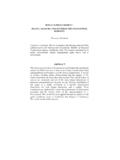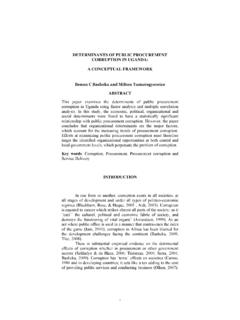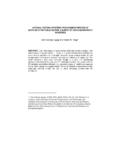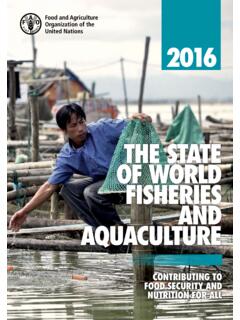Transcription of A STUDY OF THE ROLE OF PUBLIC PROCUREMENT – CAN …
1 A STUDY OF THE ROLE OF PUBLIC PROCUREMENT . CAN PUBLIC PROCUREMENT MAKE SOCIETY BETTER? Jeong-Wook Choi Jeong-Wook Choi is a Professor of School of Business in Kookmin University at Seoul, Korea. He received his at University of Illinois at Urbana-Champaign. His teaching and research interests are purchasing & supply management and supply chain management. Abstract The size of PUBLIC PROCUREMENT is quite considerable. It accounts for a significant proportion of the demand for goods and services in the nation and is increasingly considered as an attractive instrument for developing society and nation. As a matter of fact, PUBLIC PROCUREMENT has come to play a major role in making society better, and thus, there has been much research in PUBLIC purchasing and its efficient operations. However, while many people have discussed the effects of PUBLIC PROCUREMENT in many related issues and areas, little research has been done on the broad spectrum of the role of PUBLIC purchasing.
2 Based on previous literature reviews, extensive case analysis, and interviews with Korean PUBLIC PROCUREMENT officials, a new model is developed to describe the entire aspect of the role of PUBLIC PROCUREMENT . 1. The role of PUBLIC PROCUREMENT The PROCUREMENT is defined as acquiring resources from outside suppliers. In this sense, PROCUREMENT activities are very critical to all organizational units from households to firms, organizations, and the government. From the functional viewpoint, PROCUREMENT is an indispensable activity and its successful achievement is essential to any organization. In the private sector, PROCUREMENT is considered as a profit center to maximize the firm's profit in saving material cost. However, there is a major distinction in PUBLIC PROCUREMENT as it draws its funds from tax revenue. Hence, unlike PROCUREMENT in the private sector, governmental PROCUREMENT should reflect PUBLIC concerns as well as efficiency.
3 Nevertheless, both are quite similar in many ways such as cost savings, quality assurance, supplier relationship, PROCUREMENT ethics, supply market analysis, green PROCUREMENT and so on. The size of the PUBLIC PROCUREMENT is quite considerable. In Korea, PUBLIC authorities spend approximately 10 % of the Korean GDP. Thus, PUBLIC PROCUREMENT accounts for a significant portion of the overall demand for goods and services and is increasingly seen as an attractive and feasible instrument for developing society and nation. Therefore, a simple policy of PUBLIC PROCUREMENT can make a profound impact on a nation or industry. As a matter of fact, PUBLIC PROCUREMENT has come to play a major role in enhancing the quality level of PUBLIC and private sectors, and there has been much research into PUBLIC purchasing. Thai (2008), Monczka et al. (2008) and Burt et al. (2009) have explained the general aspect and characteristics of PUBLIC PROCUREMENT in their works.
4 Cohen et al. (2002), Edler and Georghiou (2007) discussed the influence of PUBLIC PROCUREMENT on industrial R&D and Carter (2000) addressed socially responsible purchasing practices, and Rose-Ackerman (1999) and Soreide (2002). investigated the ethical issues of PROCUREMENT . Also, Bhatnagar, (2003) mentioned e-Government and Fox et al. (2002) discussed social responsibility, and Beste (2008) discussed green purchasing policy. While many people have discussed the effects of PUBLIC purchasing in many related issues and areas, little research has been done on the broad spectrum of the role of PUBLIC purchasing. Based on the previous literature reviews, extensive case analysis and interviews with Koran PUBLIC PROCUREMENT officials, a new model has been developed to describe the whole aspect of the role of PUBLIC PROCUREMENT . In this paper, this role can be classified into five categories (i) The national economic contribution, (ii) The leadership in government officials, (iii) Social responsibilities, (iv).
5 Eco-friendly activities, and (v) Industry innovation, which can be seen in <Table 1>. The complete research for each area will be discussed in the chapters following. < Table 1: The role of PUBLIC PROCUREMENT >. National economic contribution Leadership in Social government Role of responsibilities officials PUBLIC PROCUREMENT Eco-friendly Industry activities innovation 2. National economic contribution PUBLIC PROCUREMENT can make a major impact on national economy. On average, total PUBLIC expenditures by central and local governments (including consumption and investment expenditures). are estimated to account for about 10% of GDP in Korea. In addition, in some sectors, government PROCUREMENT tends to be one of the most important source of sales ( defense industry, health industry or research-related industries, construction, energy, transport equipment). < Table 2: Korean GDP and PUBLIC PROCUREMENT Expenditures >.
6 (Unit: hundred million Won). Year 2004 2005 2006 2007 2008. GDP 8,268,927 8,652,409 9,087,438 9,750,130 10,239,377. P. P. 767,633 832,077 837,586 920,352 1,009,364. Ratio * P. P. = PUBLIC PROCUREMENT Expenditures * Ratio = P. P. / GDP. Thus, if we can save a small portion of the PUBLIC PROCUREMENT expenditure, the government can relocate their resource to other valuable areas. If the Korean PUBLIC PROCUREMENT Service (PPS) can save 10% of its budget in 2008, one trillion Korean Won could be relocated to other areas such as the social welfare sector which would significantly improve Korean society. How can this expenditure be saved? Even in private industry, cost savings and reductions of PROCUREMENT materials and services have been considered to be one of the most important PROCUREMENT activities to make a company successful and this can apply to PUBLIC PROCUREMENT as well. There are many ways and methods of affecting this, but first of all, PUBLIC PROCUREMENT officials have to understand cost structure, cost behavior and the supply market to maximize this opportunity.
7 Traditionally, value engineering, value analysis, market forecasting, consolidation of requirements, standardization of materials, buying consortium, power negotiation, competitive bidding, long-term contract and supply base optimization are the most famous methods to reduce the cost of PROCUREMENT . PUBLIC PROCUREMENT continuously tries to find better ways of achieving these ends. Since Korea has very limited natural resource, it is essential to provide raw materials without disruptions or unexpected price increases. The nature of the raw material market is highly volatile. PUBLIC PROCUREMENT has a leading role in managing it. Because of the uncertainties in this market in the world, PUBLIC PROCUREMENT should take proactive actions to ensure continuity of supply. For example, an oil crisis or a shortage of certain raw materials can cause a disruption of production which is bad for the national economy.
8 Furthermore, since the economy is growing, the consumption of raw materials is growing larger. For example, the consumption of aluminum in the 1980s was around 100,000 tons, but 1,000,000 tons were used in 2009, which makes Korea the fifth largest nation to use aluminum as a raw material. Therefore, risk management of raw material shortage or scarcity becomes extremely important to the national economy. The Korean PPS recognizes, evaluates and tries to measure the risks involved in raw material uncertainty and takes early action to prevent them as best as they can. If it is necessary, they can purchase certain materials and reserves against rainy days. They can also try multiple sourcing strategies to diversify the risk. Nevertheless, if a risky event is unpredictable, they prepare a contingency plan to handle these situations. One step further, the Korean PPS is now trying to establish a raw material buying consortium.
9 Since Korea, Japan and China are the very big customers in raw material markets in the world, they can achieve a great deal of cost savings or acquire greater buying power if they cooperate. At the same time, The Korean PPS has carried out the government stockpiling operation for the purposes of stabilizing prices and helping to maintain a balanced supply and demand. The stockpiling operation covers materials with high foreign dependency as well as high relevance to the industry. Korea is generally reported to be the 4th or 5th biggest consumer of non-ferrous metals in the world, following China, the US and Japan. In consideration of the continuous rise of international commodity prices, PPS has released stockpile materials in an effort to balance domestic supply and demand, and provide an environment whereby domestic firms may steadily continue their manufacturing activities. In particular, in the matter of assisting domestic businesses with their stable raw material PROCUREMENT while reducing risks in government stockpiling, PPS has introduced the Joint Purchase Service for raw materials.
10 PPS's Joint Purchase Service is an arrangement between PPS and small and medium size business(SMB) manufacturers whereby PPS compiles related purchase requests from SMB, determines the optimal purchase timing, and purchases raw materials on their behalf while retaining the advantage of large volume purchasing. To characterize the PUBLIC PROCUREMENT for national economic contribution, the diagram is depicted in the <Table 3>. < Table 3: The role of PUBLIC PROCUREMENT for national economy>. National economic contribution Financial resource Supply Stable allocation continuity economy PUBLIC PROCUREMENT 3. Leadership in government officials The governmental system is very complicated and not easy to innovate for many reasons. In this context, The Korean PPS is trying to show the excellence of operating the whole system in more innovative ways. PPS identifies how to maximize the efficiencies of government's budget execution, how to develop electronic and transparent work process system and how to find more innovative ways to operate the organizations.











